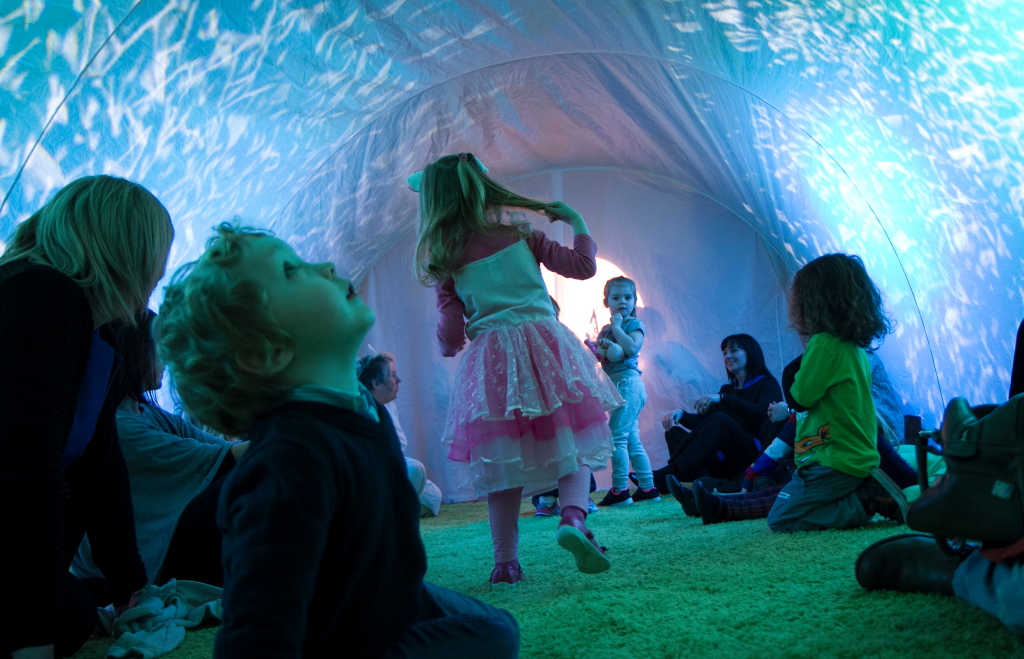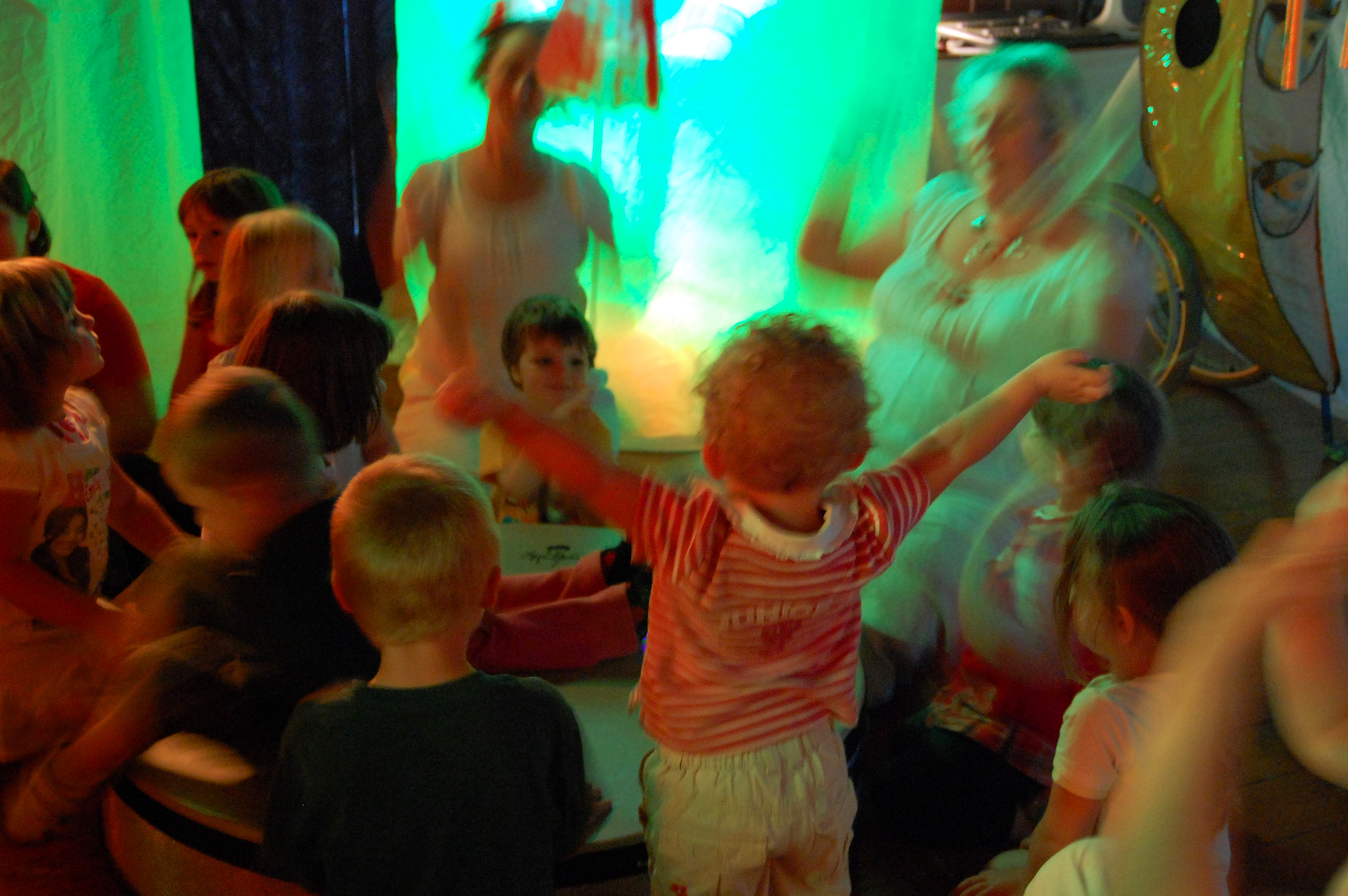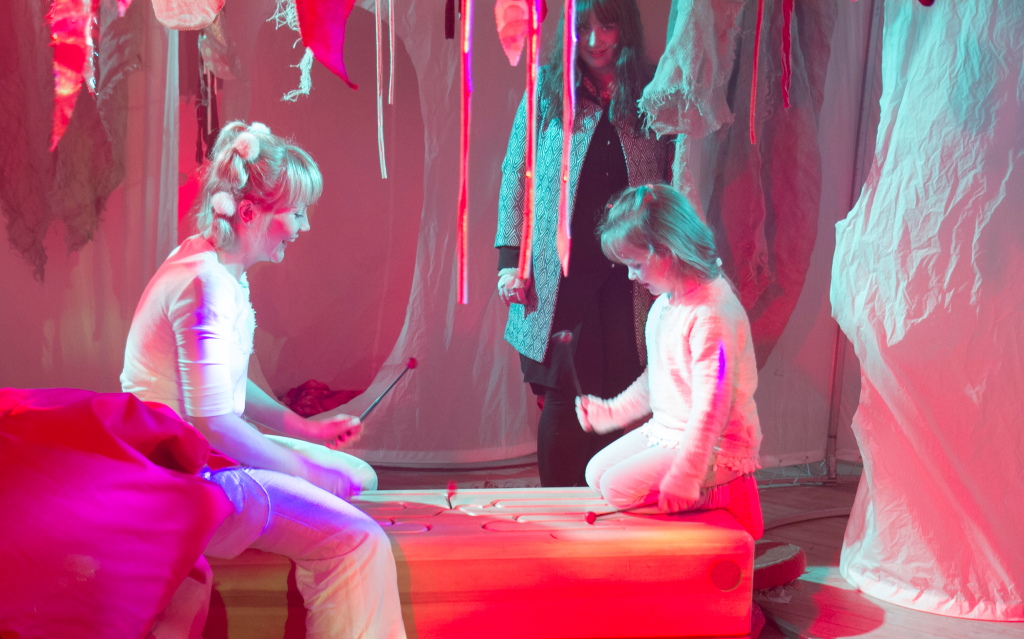A Luminous, Musical, Interactive Spectacular for Babies and Toddlers.
What are the goals of the work?
Magic Adventure is an interactive performance or ‘happening' in a large installation made of white fabric and coloured lights. It features voice play, music making, funniness, exploration and discovery. It was created in 2001.

The elements of Magic Adventure have been created and developed in partnership with young children in the day-to-day practice of its cast members – all of whom are experienced early childhood music specialists/artist-educators. A typical Magic Adventure residency lasts for several days and takes place in a large hall or other suitable space in partnership with local nursery settings, children's centres and pre-schools. Creative professional development is offered to educators from settings in the locality and also to artists and music educators.
The Goals of the work are to:
- Create (and inspire others to create) an inspirational and immersive environment for very young children and their parents, carers and educators;
- Promote and showcase improvisational techniques as a pedagogical tool for sup-porting child-led exploration, discovery, and communication; and
- Develop understanding of young children's multimodal expression – which assimi-lates music, movement, funniness, voice-play, facial expression and a variety of ma-terial objects
The Ethos of the work is to:
- Highlight educational and artistic work which builds positive, playful, creative rela-tionships;
- Highlight that babies and young children are highly competent, discerning, and de-serving of high quality arts experiences;
- Provide a space—physically, aurally, aesthetically and emotionally—that supports adults to support children;
- Explore, develop and share pedagogical approaches that are flexible and improvised in order to support young children's unique and varied learning dispositions; and
- Highlight and celebrate the innate creativity in young children and to see them as valuable creative partners to anyone working in creative arts.
The approach fits with the guiding principles of the Early Years Foundation Stage (2016) [see http://www.foundationyears.org.uk/files/2012/03/Development-Matters-FINAL-PRINT-AMENDED.pdf] and supports prime and secondary areas.
Specific outcomes are as follows:
- Children are enabled to express themselves creatively;
- Children, families, carers and educators are inspired by a powerful aesthetic experi-ence;
- Children's curiosity and creativity is valued and supported;
- Adult educators are encouraged to see children's competencies in a different light;
- Parents and educators are inspired to develop effective creative practice;
- Educators are inspired to talk less and use more voice-play and musical communica-tion within settings;
- Educators are inspired to explore and adopt a more flexible, imaginative, spontaneous practice; and
- Artist Educators find inspiration and tools for their own practices.
What is the context of the work?
The installation itself is the prime setting. It is designed to transform visually and aurally during the performance/session, which lasts around an hour and 20 minutes. Magic Adventure is targeted and children aged 0-3 years. There are also some sessions just for babies and carers; other sessions are for mixed family groups, some sessions are for toddler/2 years old settings, up to 4 years old. There are 20 places—adults and children—per session.

Magic Adventure is designed to be a major stand-alone event that is intended as a flagship celebration or catalyst for change and led by highly experienced early years artist-educators . However, every single element of Magic Adventure has been (and is being) created and developed in research partnership with young children in the day to day practice and every day context of the cast members which includes work with families, work in educational settings and creative training for artists and educators.
What is the content of the work?
In the musical content of the work, children:
- Find and explore a wide variety of sounds and high quality musical instruments;
- Play and explore alongside family, carers and peers;
- Become immersed in a three-dimensional aural landscape;
- Listen to, and are encouraged to play and join in with, singing, voice play and in-strumental music;
- Integrate music making multi-modally with a variety of activities – such as moving, throwing, playing, and hiding;
- Make musical choices and follow individual lines of enquiry; and
- Express feeling and ideas through music making.
What are the key features of the teaching and learning approach?
Key features of teaching and learning are to:
- Create an enabling and inspiring musical environment;
- Encourage positive relationships and artistic co-creating between children, adults and music artists;
- Recognise and celebrate a conception that children may be seen as experts in their own learning; and
- Adapt the experience to a wide range of learning styles and dispositions.
There is no talking. The cast use voice-play, singing and playful interaction to communicate. Early years educators are asked not to use directional speech and instead to be alongside the child. The Magic Adventures cast model desired behaviours, in an approach which is flexible and spontaneous and encourages playful interaction. The cast work alongside adults and carers to model how best to follow the child's lead and to respond positively.

The cast seek to be empathetic towards both children and adults in order to shape and support. The cast are also skilled and experienced collaborative improvisers and seek to re-spond to the impulses of groups and individuals. This includes knowing when to stand back. The cast are skilled singers and musicians who are able to respond musically and authenti-cally. The music has been composed by a specialist in music and communication in young children and includes live songs and recorded soundscape tracks for the purpose of en-couraging interaction vocally and through instrumental improvisation.
During open-ended, explorative sections in the session, large ‘pallets' containing high quality musical instruments are placed around the environment. A soundscape track is played during these explorations, which is in the same pentatonic scale as used by the tuned instruments. Short set pieces happen periodically throughout the show—songs, light shows— which introduce new elements or provoke new interactions.
The whole adventure was a surprise and one which I will always remember. Our usually shy children (girls especially) were very confident - lovely to see.
How is the work being reviewed?
The work is being reviewed by evidence from the following sources:
- Being documented and captured through video;
- Assessing children's levels of wellbeing and involvement (using the Leuven scale );
- Feedback from practitioners, parents immediately after the show. (What they thought, what they thought their children had experienced, what they would take away)
- Short feedback forms and sound bites;
- Feedback from practitioners by writing after a period of reflection;
- In-the-moment reviews that are undertaken constantly by the cast members during a performance; and
- The content and approaches are consistently being researched and developed by the cast members and the young children with whom they work day-to-day. The team include more measurements when they work over a period of time with children – such as in the use of voice and interaction with peers.
What are the positive outcomes for children/young people – are they some or all of musical, social, personal, educational - how and when can they be identified?
The positive outcomes include some or all of the following:
- A rise in children's wellbeing, which is reported by significant adults in their lives;
- A rise in children's self-expression, which is reported by significant adults in their lives;
- Children's self-expression being evident and also valued and shared by others;
- Children are immersed in a musically multi-modal environment;
- Educators often report seeing children in a different, more competent light;
- Educators are inspired to find less directional ways to work with children;
- Educators value music in the setting more;
- Educators are inspired to work more creatively;
- Children, parents and educators feel uplifted and inspired; and
- Parents and children experience a unique and very positive time together.
What are the key features of teacher/leader behaviour that are enabling those positive outcomes?
The core team demonstrate high levels of improvisation skills, both musically and commu-nicatively. The ability to tune into individual and group behaviours is commonly evidenced, as is the ability to switch from mode to mode and to work multi-modally.
What are the key features of context, content and activities that are enabling those positive outcomes?
Magic Adventure is contained within a very beautiful, exciting and enabling environment that has been developed over many years. Activity includes open ended free-play, alongside a smooth flow of transforming activities.
I have noticed that more of the children are singing and making up songs. Some of the children who normally wouldn't engage in music time are joining in with a lot more focus.
What other factors in this case are contributing to those positive outcomes?
There are high quality instruments. Additionally, there is investment and vision into making a Magic Adventure residency happen.
How replicable or adaptable is it?
As currently conceived and enacted, Magic Adventure is large and expensive, but most of its key elements and all of its principles are replicable. Feedback from parents and practitioners has shown that many key ideas are taken from a residency. Each residency offers professional development to host settings around the replication of key ideas in the setting.
Resources
- Magic Adventure Official Website: http://www.magic-adventure.co.uk/video
- Magic Adventure Videos: http://www.magic-adventure.co.uk/video
